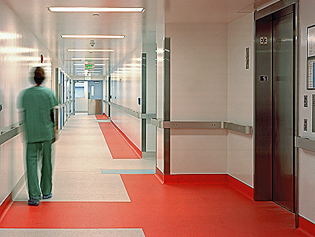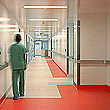The UCSF animal care facility, known as the Parnassus Services Building, has been named Facility of the Year by the publishers of Animal Lab News.
Animal Lab News, recently announced the winners of its 2006 TurnKey Awards, which recognize outstanding achievements in the design and construction of a new or renovated laboratory animal facility.
Awards will be presented at the TurnKey Conference in Baltimore, MD, on April 19 and 20, when participants will learn useful information on the latest technology and trends in facility construction, renovation and equipment.
"The Parnassus Services Building was noted for its environmental considerations, the attention to the work environment for staff and the ways in which the site obstacles were overcome," says Patrick Murphy, president of Vicon Publishing Inc., which presents the TurnKey Awards.
Designed by internationally recognized animal laboratory architects Flad & Associates, the Parnassus Services Building opened in March 2005.
Ivy Chiao, longtime project manager for UCSF Capital Projects and Facilities Management, headed the project team, which included program planner GPR Planners Collaborative Inc., building contractor McCarthy Building Companies and the Owners Construction Manager, Herrero Contractors Inc. The planning also involved extensive input from a building committee and University user representatives in all facets of the project to ensure that UCSF's needs would be met.
 |
|
"The completion of the building reflects the contributions of many individuals who overcame numerous challenges to make this facility a reality," Chiao says. "The main element that contributed to the success of the project was the spirit of teamwork, collaboration and cooperation by all team members. Functionally and operationally, the building has proven to be efficient and effective and greatly improving conditions for all of the animal staff."
The six-story, 85,740-square-foot building houses a basement, service area that includes a robotic cage washing system, loading dock and state-of-the-art surgical suite, as well as large animal housing, and three floors of rooms for rodents.
Innovative Features
The Parnassus Services Building incorporates a number of innovative achievements. These innovations include:
• Direct connection of the ventilated cages to both building supply and exhaust systems, minimizing exposure to animal allergens and odors within the holding rooms;
• Implementation of a robotic cage washing system that automates the changing of bedding and dispensing debris to maximize operational efficiency and minimize problematic ergonomic and staffing issues;
• Touch panel control stations in each area of the animal floors to allow local observation and control of individual room environments;
• Accessible overhead mechanical space providing access to all key components without the need to enter the animal space below;
• Incorporation of natural light into the corridors, break rooms and many of the procedure rooms without compromise of overall building security and privacy;
• Interior design that uses color-coded flooring to signal directional flow, so that personnel move from clean to soiled areas, and compartmentalization to minimize the potential for cross-contamination and spread of contagious disease; and
• Adaptation of special laminated fiberglass reinforced panels for use in cage wash and large animal holding rooms.
Better Environment
For Clifford Roberts, DVM, director of the Laboratory Animal Resource Center at UCSF, the Parnassus Services Building represents a huge improvement over the two previous animal facilities, which were originally constructed in 1940 and 1949. In fact, the Parnassus Services Building in many ways exceeds industry standards, and Roberts considers it among the best animal research buildings in the United States.
"The biggest improvement is the ventilation," he notes. "Each cage is individually ventilated, so that we can better control the air flow and reduce odors. This is a real advantage for both the animals and the staff."
Indeed, considering that each room typically holds some 700 cages of mice, ensuring adequate ventilation is critical to the work environment for staff. Every day, about 30 of the Laboratory Animal Resource Center staff involved in taking care of the animals work in the building, along with researchers engaged in a variety of studies aimed at improving human health.
The ventilation system also minimizes the amount of energy used to maintain ideal environmental conditions and reduces operational costs, Roberts notes.
Animal research has paved the way for many medical advances of the last century and continues to advance UCSF's understanding of cancer, heart disease, chronic pain and neurodegenerative diseases such as Alzheimer's. UCSF is deeply committed to providing responsible, humane care for its research animals. Read more about animal research and care at UCSF
here.
Robotic Cage Washing
 |
|
The Parnassus Services Building also uses a state-of-the-art robotic cage washing system that cleans cages at a much faster rate than when staff used to clean cages manually. Today, 4,800 cages are cleaned daily versus 1,500 cages that were cleaned the previous way, Roberts points out. UCSF was the third academic medical center in the country to use the high-tech tool, which was manufactured in Sweden and remains monitored by modem by that firm from an office in Stockholm.
In addition, the automated system protects staff from exposure to unpleasant waste and repetitive motion disorders, thereby reducing the number of workers' compensation cases.
Similar to a dishwasher, the robotic system uses racks to hold the cages, which are then carried four at a time to be scraped and then loaded onto a conveyor belt into the washer. After a thorough washing, the cages are rinsed and then dried automatically. The clean cages are then loaded onto racks for use again.
Today, only a few odd-sized cages that do not fit on the racks are washed the old way.
Importantly, the waste emptied from each cage also goes directly into a dumpster, which is hauled away several times a week by Sunset Scavenger Co. The debris is then delivered to a Vacaville composting facility. Roberts estimates that the Parnassus Services Building sends about 1 million pounds of compostable material a year.
Another staff-friendly feature is the use of windows along corridors and in corner break rooms.
"The Parnassus Services Building introduced windows at the ends of main corridors to give staff exposure to natural light, which is relatively rare for an animal care facility," says John Mickow, principal architect for Flad & Associates.
Needless to say, the Parnassus Services Building is a marvel of construction, given the limitations of a crowded urban campus where open space is at a premium.
"The primary challenge was fitting the building into a tight spot," Mickow says. "It was a huge challenge from the standpoint of construction and it involved a highly orchestrated process."
Photos courtesy Flad & Associates
Source: Lisa Cisneros
Links:
Animal Lab News announcement
Animal Research and Care at UCSF





